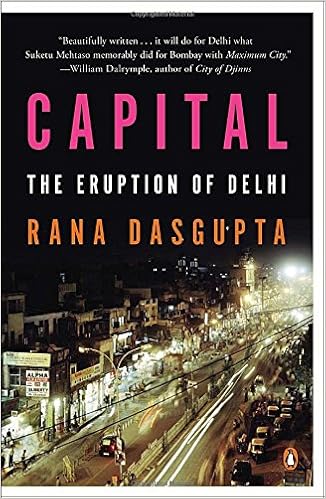Read in ‘Capital. The Eruption of Delhi’ (2014) of Rana Dasgupta:

Great portrait of Delhi, India, that I’m reading. The writer is Rana Dasgupta, originally from New York, but now living in the Indian capital. It’s his first nonfiction book, but sometimes I’m not sure. At least it’s a personal quest for the soul of a city. Dasgupta immediately loved Delhi, he writes, and after he arrived he met so many people, so by writing down all their stories he learned about the real life in the fast growing metropolitan region. At that very moment the vast country had gone through a decade of the changes resulting from the liberalisation of the economy after 1991. Then the urban fabric still looked the old. But one year later the tearing-down began. “I had fallen, by pure chance, into one of the great churns of the age and, without ever planning to do so, I stayed.” So he writes about the removal of hundreds of thousands of homes of the poor, the building of shopping malls and apartment blocks, “this enormous transfer of wealth and resources from the city’s poorest to its richest citizens,” the destroying of so many businesses in the name of aesthetic order, the maximizing of floor area and sale prices, the coming of restaurants and bars, coffee shops even. It left him and many others with the feeling that what was happening here, would change the entire world.
Dasgupta resolved to start with the torrent of Delhi’s inner life, “and to seek there the rhythm, the history, the mesh, from which a city’s lineaments might emerge.” While most people around him were convinced the city is losing its soul, he started to think there was a city to be made. I could not stop reading. I’m still in the middle of it. Modern Delhi, Dasgupta writes, was born out of the catastrophe of india’s partition. The city is the pioneer of India’s private townships. Gurgaon is the largest such township in Asia, and has imitators now all over the country. On the rush of Indian business process outsourcing to the enormous brushland zone of high-tech real estate in this new suburb of Gurgaon, close to the airport in the neighboring state of Haryana, triggered by the coming of General Electric in 1996, he discovered a new Delhi. And then all those young Indians coming to the capital, working hard, earning money, possessed with great energy and talent, taking over the old city of bureaucrats, turning it into twenty-first century India’s cultural centre. The new generation looks up to them with respect and adoration. It’s a revolution. When did I visit Delhi the last time? That was 1988. I should go back and see it. But first read the whole book.
Geef een reactie